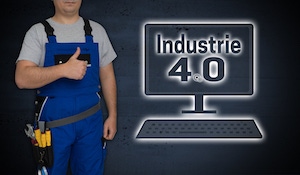While advances in technology can open up a number of opportunities for various functions, automation will make a lot of jobs redundant, according to an article from Frost & Sullivan (San Antonio, TX).
June 5, 2018

 It’s pretty obvious that Industry 4.0 will impact the global workforce, but how? According to business consulting firm Frost & Sullivan (San Antonio, TX), the concept of automation and digitization of everything is now a reality. In a May 31, 2018, blog post at Frost Perspectives, “Global Workforce Transformation in the Era of Industry 4.0,” the company noted that with the rapid adoption of digital technologies, organizations are transforming not only their structures, but also their workforce capabilities.
It’s pretty obvious that Industry 4.0 will impact the global workforce, but how? According to business consulting firm Frost & Sullivan (San Antonio, TX), the concept of automation and digitization of everything is now a reality. In a May 31, 2018, blog post at Frost Perspectives, “Global Workforce Transformation in the Era of Industry 4.0,” the company noted that with the rapid adoption of digital technologies, organizations are transforming not only their structures, but also their workforce capabilities.
Manufacturers are making substantial investments in new technologies such as artificial intelligence, 3D printing and industrial robots that enable fully automated and digital manufacturing capabilities to improve the overall manufacturing process. The concept of Industry 4.0 revolves around production, seamless communication of data, automated workflow and digitization of manufacturing processes including product and service offerings, said Frost & Sullivan.
In today’s world, disruption is not only limited to technology, products and services but also affects the workforce and its capabilities. In the era of digitization, this disruption can be termed as Workforce 4.0. It requires manufacturers to invest in talent possessing cognitive abilities, certain skills and technical aptitudes, complemented with problem-solving abilities and proficient resource management, according to Ddiworld.com.
But the big question is: How is this ongoing trend impacting the global workforce? How does a manufacturer create a better and faster workforce? Frost & Sullivan answer this by correctly observing that growing automation needs and demand for digitization are changing the nature of work and putting pressure on the present workforce.
Many people in today’s workforce feel threatened by the use of automation, fearing the loss of their jobs to a robot. But, as Frost & Sullivan comments, “Manufacturers are in great need to reinvent themselves in terms of [their] workforce and prepare it for more value-added responsibilities. Manufacturers now are investing in acquiring tech-savvy talent and up-skilling the faculty to be able to leverage the new technology and adapt to its implications.”
With integration of the Internet of things (IoT), it is imperative for companies to reassess their talent and restructure their recruitment processes and strategies for evolving job requirements. Rapid industrialization necessitates workers to quickly integrate the new skill sets.
Skilled talent is in short supply in many industrial segments such as automotive, plastics processing and mold manufacturing; the skills gap is one of the primary pain points that keeps CEOs up at night, according to various surveys. Frost & Sullivan offers some advice:
Emphasize quality, not the cost of talent. The needs of the production workforce are changing and talent acquisition must be based on attributes that are aligned with critical business strategies to drive the organization to higher levels of performance. An emphasis on quality rather than cost of recruitment helps organizations identify high-potential workers with elusive technical skills that help accelerate time to productivity.
Engage in efficient workplace interactions. From time to time, leader-employee interactions along with team meetings and discussions regarding day-to-day operations not only enhance the self-esteem of employees, but also encourage their involvement in processes and strengthen team capabilities.
However, notes Frost & Sullivan in its report, every disruption brings with it some challenges. While advances in technology can open up a number of opportunities for various functions, automation will make a lot of jobs redundant. This is primarily because increased levels of automation are capable of handling complicated and physically demanding work, replacing the jobs of people working on this front for decades.
“While new levels of automation do increase productivity and growth, this trend is impacting employment rates,” Frost & Sullivan said. “The advent of Industry 4.0 and its benefits also marks the beginning of structural changes in terms of socio-economic perspectives in the world of employment. Manufacturers need to strike a perfect balance between highly skilled workers and social security implications.”
Many economies that have witnessed the massive adoption of advanced manufacturing techniques have recorded new levels of efficiency, productivity, and growth in spite of having limited human jobs. This new automation-enabled wealth is increasingly being considered by some countries, including Germany, to fund subsidies, basic unemployment insurance and a universal basic monthly income to their citizens. However, not all countries are open to such a transition.
Keeping technology and automation in mind, Frost & Sullivan state that many companies have started employee training programs to prepare their workforce for the digital world. Many such digital training programs have also been introduced in schools and vocational educational institutions to develop the required skills that the automation world demands.
“Given the ongoing technology transformation, the future of the manufacturing workforce looks exciting," Frost & Sullivan concludes. “Adoption of these new workforce management technologies, supported by workers’ unique characteristics—such as creativity and empathy—will certainly provide a business advantage to companies.
“However, the important question here is how our business leaders will approach this technology transformation and take a lead in the adoption of these innovative tools. This will redefine and reinvent the workplace for tomorrow.”
In part 1 of this series, Clare Goldsberry looks at the impact Industry 4.0 will have on small to mid-sized businesses.
About the Author(s)
You May Also Like




